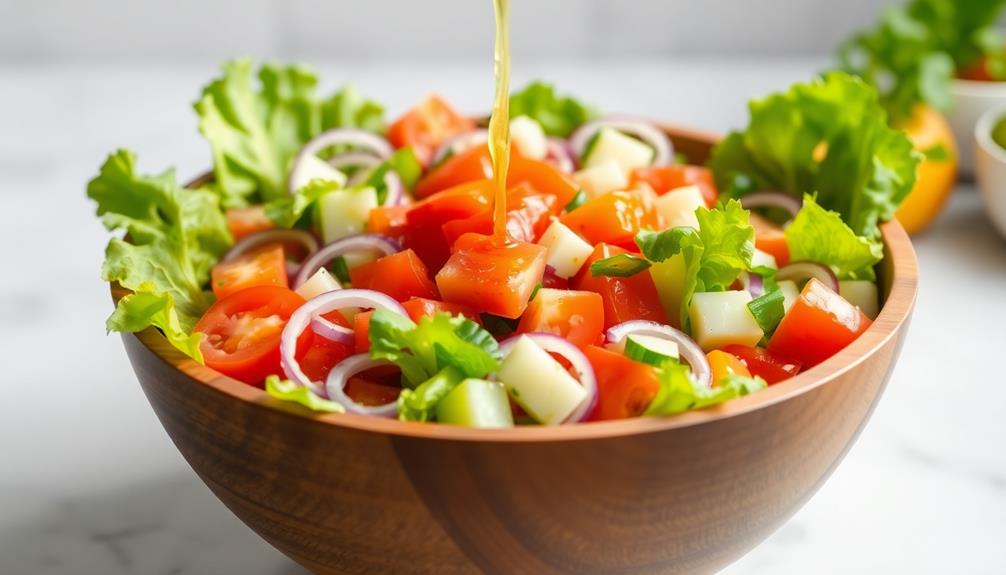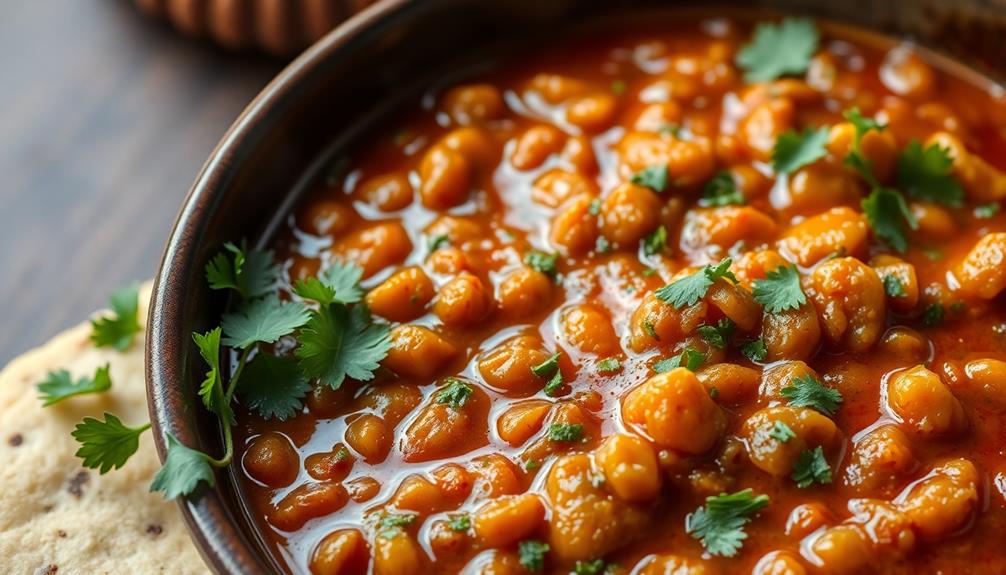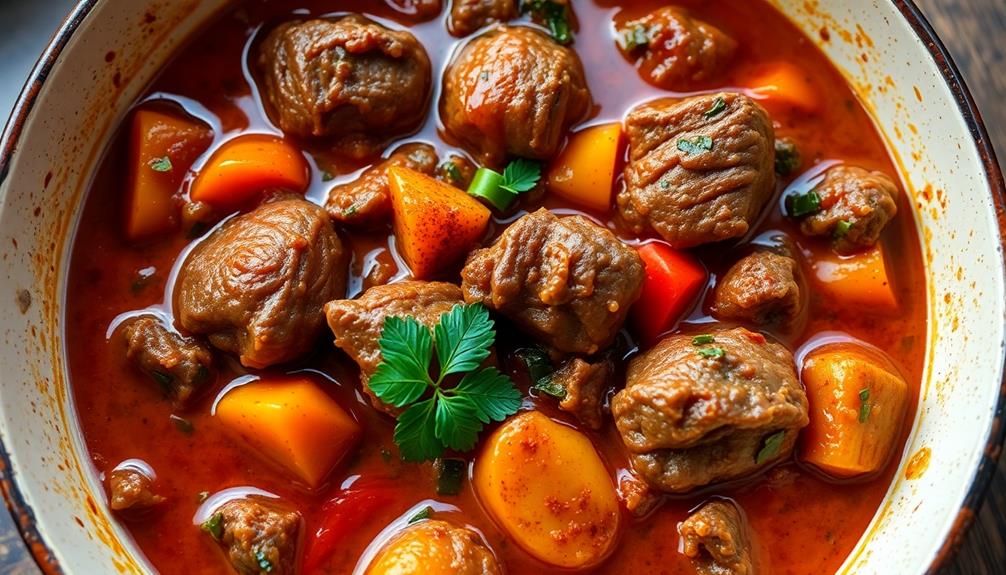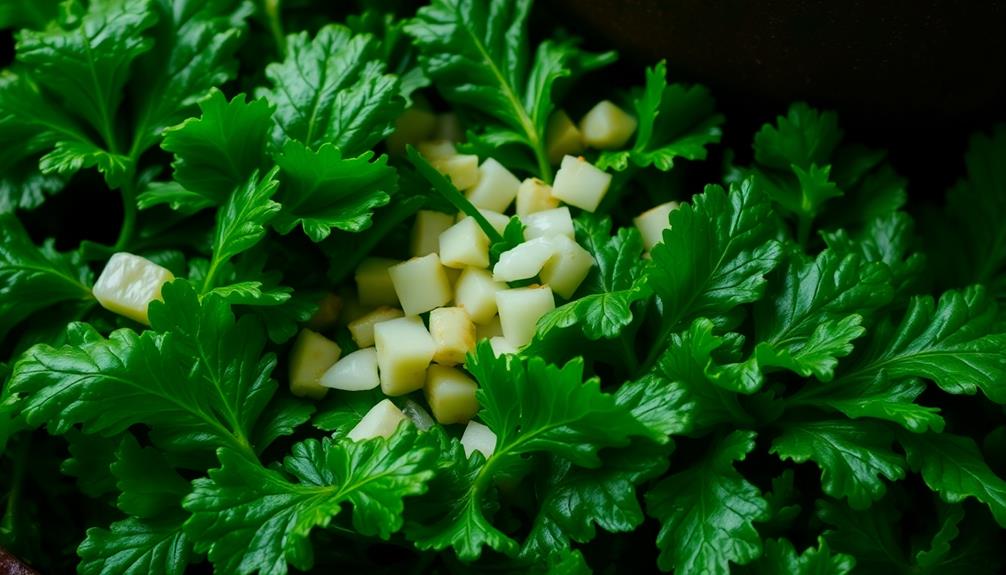Ye'selata is an incredible Ethiopian salad that reflects the rich culture and diverse culinary traditions of the Horn of Africa. You'll often find it prepared communally during special gatherings, highlighting its social significance. This vibrant dish combines fresh vegetables like crisp romaine, juicy tomatoes, and crunchy onions, dressed in a tangy dressing that creates a burst of flavors in every bite. It's a versatile salad you can enjoy as a side, light main course, or snack. The secret to its success lies in balancing textures and flavors – and if you keep reading, you'll discover more about the preparation and serving suggestions that make this salad truly remarkable.
Key Takeaways
- Ye'selata is a vibrant Ethiopian salad combining fresh vegetables, herbs, and a tangy dressing, reflecting the diverse culinary traditions of the Horn of Africa.
- The dish is often prepared communally during special occasions, highlighting its social aspect and serving as a versatile side, light main course, or snack.
- The success of Ye'selata lies in balancing textures and flavors, particularly with crisp lettuce, juicy tomatoes, and crunchy onions, using seasonal ingredients.
- Presentation and serving suggestions, such as topping with toasted walnuts and crumbled feta, can enhance the dish's appeal and enjoyment.
- Understanding the economic implications of ingredient sourcing can inform culinary choices and preparation, allowing for better decision-making in the kitchen.
History
The origins of the Ethiopian salad can be traced back to the diverse culinary traditions of the Horn of Africa region. From the fertile lands of the highlands to the coastal areas, the ingredients that make up this vibrant dish have been a part of local diets for centuries.
Ye'selata, as it's known in Amharic, the official language of Ethiopia, is a reflection of the country's rich cultural heritage. The combination of fresh vegetables, flavorful spices, and tangy citrus notes creates a harmonious balance that has delighted generations of Ethiopians.
As families gather for special occasions, the preparation of this salad becomes a communal affair, with each member contributing their own touch to the final result.
The versatility of Ye'selata is another reason for its enduring popularity. It can be served as a side dish, a light main course, or even a refreshing snack, making it a beloved staple in Ethiopian cuisine.
Recipe
Ethiopian salad is a vibrant and flavorful dish that combines a variety of fresh vegetables, herbs, and a tangy dressing. The salad is a staple in Ethiopian cuisine and is often served as a side dish or a light main course. Incorporating seasonal ingredients can enhance the flavors even further, making it a perfect addition to any farm-to-table meal.
The key to a delicious Ethiopian salad is the perfect balance of textures and flavors. The crisp lettuce, juicy tomatoes, and crunchy onions are complemented by the earthy spices and the tangy dressing, creating a harmonious blend of tastes.
Ingredients:
- 1 head of romaine lettuce, chopped
- 2 large tomatoes, diced
- 1 red onion, thinly sliced
- 1 cucumber, diced
- 1 bell pepper, diced
- 1/2 cup fresh parsley, chopped
- 1/2 cup fresh cilantro, chopped
- 1 teaspoon ground cumin
- 1 teaspoon paprika
- 1/4 cup lemon juice
- 2 tablespoons olive oil
- Salt and black pepper to taste
Instructions:
In a large salad bowl, combine the chopped romaine lettuce, diced tomatoes, sliced red onion, diced cucumber, diced bell pepper, chopped parsley, and chopped cilantro.
In a small bowl, whisk together the ground cumin, paprika, lemon juice, and olive oil. Pour the dressing over the salad and toss gently to coat. Season with salt and black pepper to taste.
When preparing this Ethiopian salad, it's important to use fresh, high-quality ingredients for the best flavor. You can also adjust the spice level by adding more or less paprika, and the acidity by adjusting the amount of lemon juice.
Additionally, you can experiment with other vegetables, such as shredded carrots or sliced radishes, to add more texture and flavor to the dish. For those looking to elevate their dining experience, consider pairing this salad with a fermented vegetable plate for added complexity and gut health benefits.
Cooking Steps
Rinse and chop your ingredients to prep them for the salad.
Toss the chopped veggies with a splash of lemon juice to keep them fresh.
Step 1. Rinse and Chop Ingredients

Begin by gathering all the ingredients you'll need for this refreshing Ethiopian salad.
Start by rinsing the lettuce leaves under cool, running water to remove any dirt or debris. Pat them dry with paper towels and tear them into bite-sized pieces, placing them in a large mixing bowl.
Next, rinse the tomatoes and slice them into quarters. Add the tomato pieces to the bowl.
Peel and chop the onion into small, even pieces, then add them to the mix.
Wash the cucumber, slice it lengthwise, and then into half-moons, adding them to the salad.
Finally, rinse the parsley, pat it dry, and finely chop the leaves. Sprinkle the parsley over the salad.
With all the ingredients prepped, you're ready to move on to the next step in creating this refreshing Ethiopian treat.
Step 2. Toss Ingredients With Lemon Juice

With the ingredients prepped, it's time to give the salad a refreshing zing. In a large mixing bowl, combine the chopped tomatoes, cucumbers, onions, and greens. Drizzle the lemon juice over the top, using about 2-3 tablespoons. You want just enough to coat the veggies and provide a tangy kick.
Using clean hands or a large spoon, gently toss the salad to evenly distribute the lemon juice. Be careful not to over-mix, as you don't want to bruise the delicate greens. The goal is to lightly dress the salad, allowing the natural flavors to shine through.
Once the salad is well-coated, give it a final taste and adjust the lemon juice as needed. You can add a pinch of salt and pepper at this stage too, if desired.
Now the salad is ready to serve! Spoon it into bowls or plates and enjoy the refreshing, zesty flavors of this authentic Ethiopian dish.
Step 3. Add the Dressing

Drizzling the lemon dressing over the salad brings the ingredients together, awakening their vibrant flavors.
Take the reserved lemon juice and whisk it with the olive oil, honey, and a pinch of salt and pepper until emulsified. Slowly pour this tangy, sweet dressing over the tossed salad, using just enough to lightly coat the greens and vegetables. Gently fold the dressing into the salad, ensuring every bite gets a hint of the zesty, flavorful topping.
The key is to dress the salad right before serving, allowing the flavors to meld. You don't want the greens to become soggy, so start with a small amount of dressing and add more as needed.
The vibrant hues of the vegetables and herbs will pop against the light, citrusy coating, making this Ethiopian-inspired salad a feast for the senses. Serve immediately for maximum freshness and enjoyment.
Step 4. Let Salad Chill for 15 Minutes

After dressing the salad, allow it to chill for about 15 minutes. This resting period lets the flavors meld and the ingredients marinate.
During this time, the vegetables will soften slightly, and the dressing will be absorbed, creating a more cohesive and flavorful salad.
While you wait, gather your serving bowl and utensils. This way, you'll be ready to transfer the salad once the 15 minutes are up. Chilling the salad also helps to chill the entire dish, so it's refreshing and crisp when served.
Once the time is up, give the salad one final toss to ensure everything is evenly coated in the dressing.
Then, transfer it to your serving bowl and enjoy! The cool, tangy flavors of this Ethiopian-inspired salad are sure to delight your taste buds.
Step 5. Serve Chilled and Enjoy

Once the salad has had its 15-minute chill, it's ready to serve. Proper nutrition, like the fresh ingredients in this salad, is essential for brain development and emotional well-being; nutrition's role in development can't be overlooked.
Carefully transfer the chilled salad into a serving bowl. You'll want to use a slotted spoon to ensure the tomatoes and other vegetables don't get too soggy from the dressing.
Now, give the salad a gentle toss to evenly distribute the flavors. Invite your guests to serve themselves, spooning the vibrant, flavorful salad onto their plates. Encourage them to top their portions with the toasted walnuts and crumbled feta for a delightful crunch and creamy tanginess.
This Ethiopian-inspired salad is best enjoyed chilled, so make sure everyone digs in right away. The combination of crisp lettuce, juicy tomatoes, and aromatic herbs is simply divine. For an added burst of flavor, don’t forget to drizzle the salad with some zesty lemon juice and a splash of olive oil. If you’re feeling adventurous, you can also try adding some diced avocado or crumbled feta cheese for a creamy twist. And if you want to truly bring the tastes of Ethiopia to your table, consider serving this salad alongside a traditional azifa recipe, for a complete and authentic dining experience.
Your family and friends are sure to love this refreshing, healthy dish. Don't be surprised if they come back for seconds!
Final Thoughts
Though you may have tried many salad recipes, the Ethiopian salad is truly a unique and delightful experience. Its vibrant colors, complex flavors, and nutritious ingredients make it a standout option. The blend of spices, tangy dressing, and fresh vegetables create a burst of taste in every bite.
Additionally, understanding the economic implications of various ingredients can enhance your culinary experience, especially when considering how mercantile goods impact market stability the economic implications. Don't be intimidated by the unfamiliar ingredients – they're easy to find and come together seamlessly.
The best part? This salad is endlessly customizable. Feel free to experiment with your favorite veggies, adjust the spice level, or add a protein for a heartier meal.
And don't forget to serve it chilled for the ultimate refreshing experience. Whether you're hosting a gathering or enjoying a solo lunch, the Ethiopian salad is sure to impress and delight.
Frequently Asked Questions
Is Ye'selata a Traditional or Modern Ethiopian Dish?
You're asking whether this dish is a traditional or modern Ethiopian offering. Based on the context provided, ye'selata appears to be a traditional Ethiopian salad, as it's specifically named as an "Ethiopian Salad."
What Is the Nutritional Value of Ye'selata?
The nutritional value of this salad depends on the ingredients used, but it's generally a healthy option. It's rich in vitamins, minerals, and fiber, making it a great addition to your diet.
Can Ye'selata Be Served as a Main Dish or a Side?
You can serve this dish as either a main course or a side. It's versatile enough to work in either capacity, depending on your preferences and the other items you're serving. The choice is yours!
How Long Does Ye'selata Typically Take to Prepare?
Preparing this dish typically takes around 20-30 minutes. You'll need to chop and mix the ingredients, which can be a bit time-consuming, but the overall process is fairly simple and straightforward.
Are There Any Variations or Regional Differences in Ye'selata Recipes?
There can be regional variations in salad recipes, with different ingredients or preparation methods. Some areas may use unique local produce or spices, tailoring the dish to local tastes. The specific recipe can vary across different regions.









